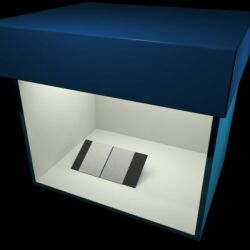 |
Computer Graphic Rendering of Material Surfaces |
 |
 |
Computer Graphic Rendering of Material Surfaces |
 |
Radiance
This project utilized the Radiance Lighting Simulation and Rendering System (Radiance) to generate synthetic images. Radiance is a suite of programs built around an advanced distributed raytracer designed for realistic image synthesis. It was selected because it is a physically-based rendering system designed to accurately model the light behavior of a scene using physical units. Using such a system reinforces the validity of the results obtained by the physics based BRDFs within OBL and those generated from NEFDS. Additionally, the source code to Radiance is publicly available and the program is currently in wide use, aiding future work.
Radiance is a distributed ray tracer which utilizes Monte Carlo importance sampling to solve the rendering equation. The rendering equation specifies the reflected radiance in direction
from the values of the surface's BRDF and the incident irradiance, integrated over all incident directions. As mentioned earlier the solution of this integral often is the most computationally expensive task of a rendering program. For this reason the solution to this integral is often found through the use of Monte Carlo integration.
Radiance was designed with built-in support of arbitrary BRDFs, but only for computing the direct contribution of the dominant light sources. (In Radiance, the dominant light sources are handled separately to reduce the variance introduced in the Monte Carlo evaluation of the rendering equation.). In order to correctly handle the contribution from the rest of the environment, a new shader, iBRDF, was developed which uses Monte Carlo importance sampling.
|
Privacy Statement/Security Notice | Disclaimer | FOIA NIST is an agency of the U.S. Commerce Department's Technology Administration. |